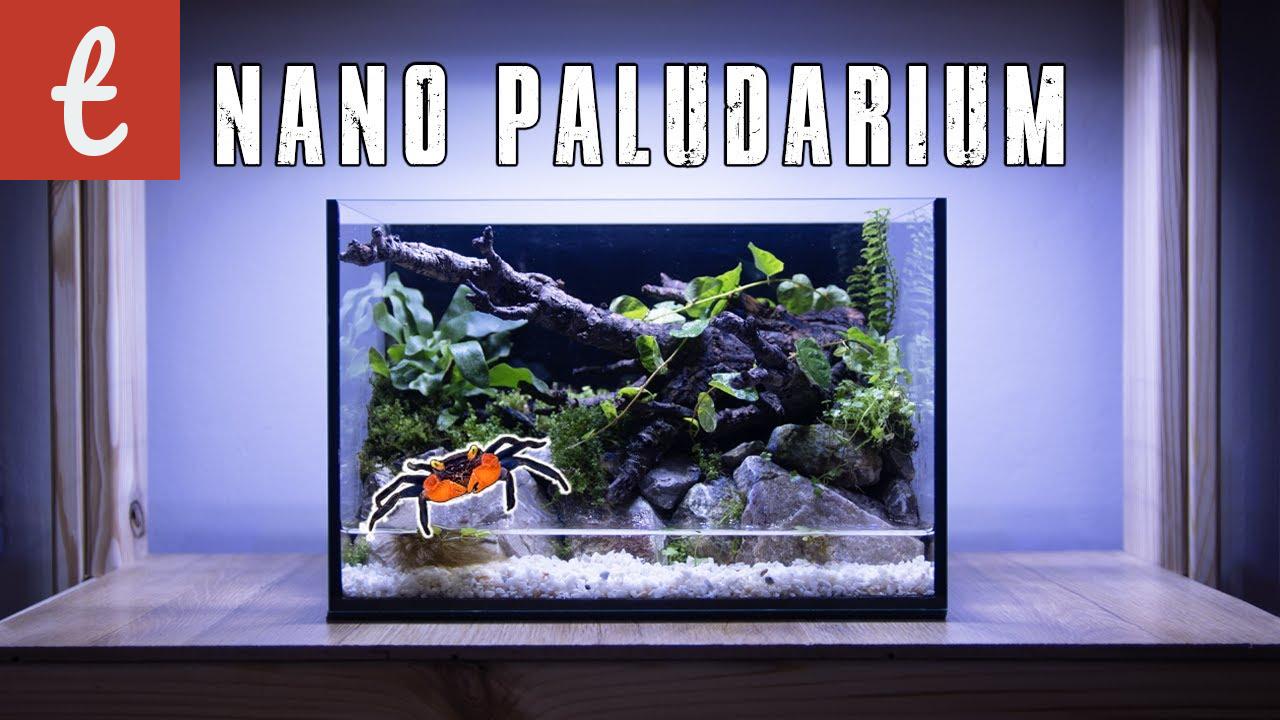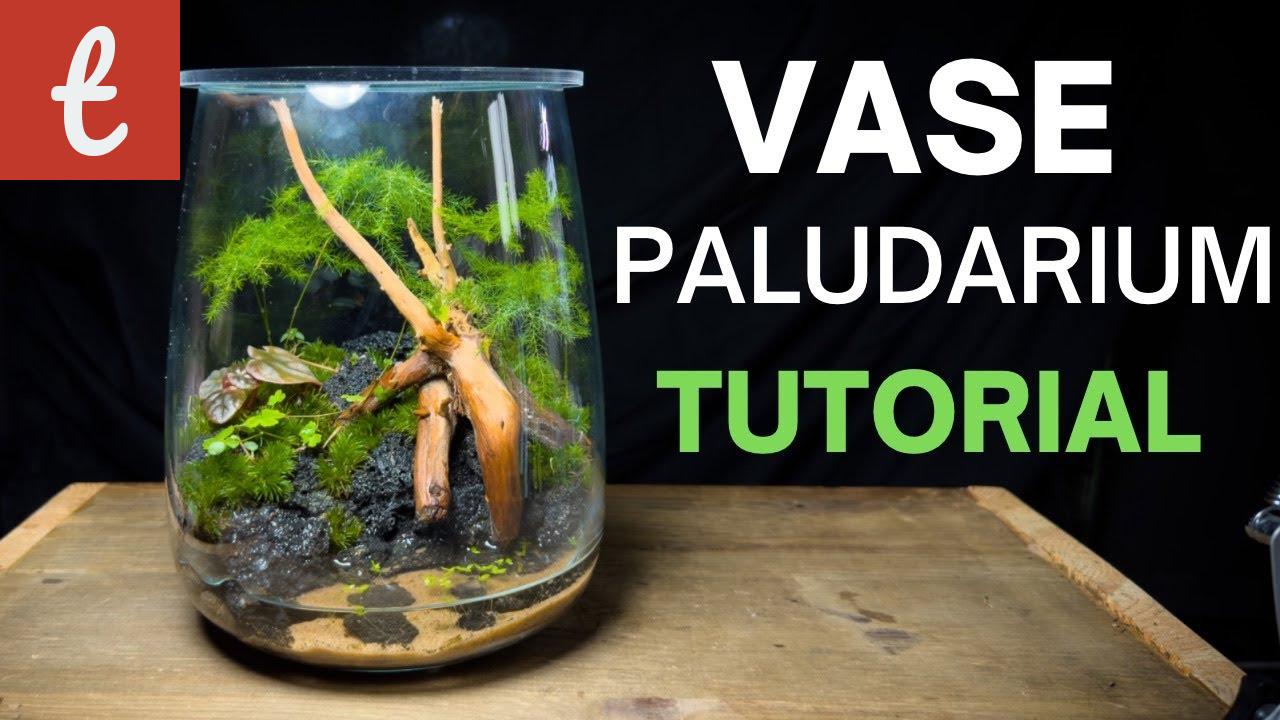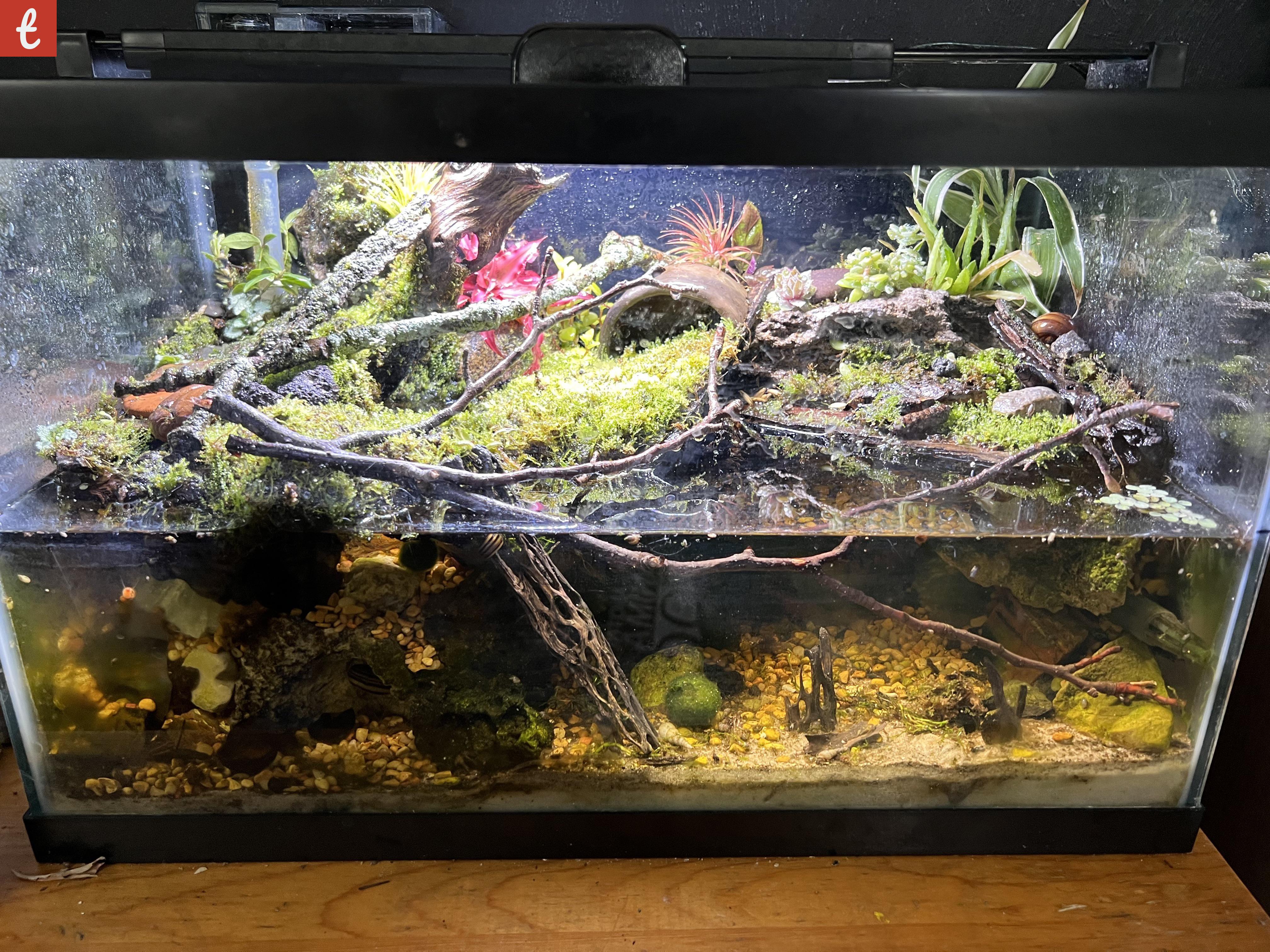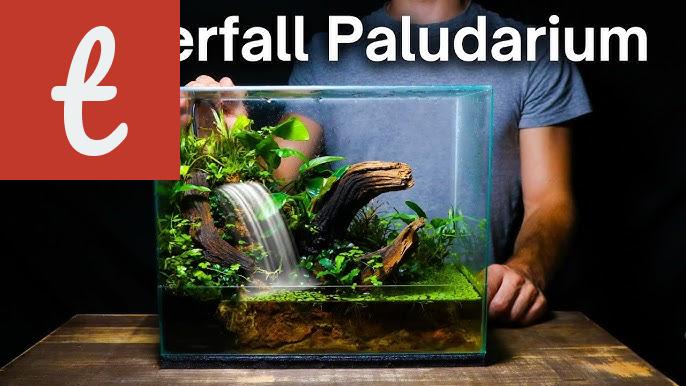The Ultimate Guide to Setting Up a Nano Paludarium
Are you looking to create a stunning and unique aquatic habitat for your home or office? Look no further than a nano paludarium! This compact and captivating ecosystem combines the beauty of aquatic plants and animals with the lushness of a terrarium. Whether you're a seasoned aquarium hobbyist or a beginner looking to try something new, setting up a nano paludarium is an exciting project that will enhance any space.
Before diving into the world of nano paludariums, it's important to understand what they are. A nano paludarium refers to a small-scale version of a paludarium, which is an enclosed environment that contains both water and land sections. This unique combination allows for a diverse range of plants and animals to thrive in a single habitat.
- Choose the Perfect Tank: The first step in setting up a nano paludarium is selecting the right tank size. A nano paludarium typically ranges between 5 and 20 gallons, making it perfect for smaller spaces. Ensure that the tank has a secure lid to maintain humidity levels and prevent any escapes.
- Create the Land and Water Sections: To create a nano paludarium, you'll need to divide the tank into land and water sections. Using aquarium-safe silicone, create a barrier to separate the areas. Consider the desired ratio of land to water, keeping in mind the needs of the plants and animals you plan to keep.
Now comes the fun part – decorating your nano paludarium! Selecting the right plants, animals, and decor is essential for creating an aesthetically pleasing and functional habitat. Here are some key points to keep in mind:
- Choose the Right Plants: Selecting the appropriate aquatic and terrestrial plants is crucial for a thriving nano paludarium. Look for plants that can tolerate high humidity and have the ability to grow in both submerged and emerged conditions. Examples include ferns, mosses, and aquatic grasses.
- Consider the Fauna: Depending on the size of your nano paludarium, you can introduce a variety of animals. It's essential to research the specific needs and behavior of each species to ensure compatibility. Popular choices include small fish, shrimp, frogs, and snails.
Maintaining a healthy nano paludarium requires proper care and attention. Here are some essential maintenance tips:
- Monitor Water Quality: Regularly test the water parameters such as temperature, pH, ammonia, nitrite, and nitrate levels. Make sure to provide proper filtration and perform partial water changes as needed.
- Prune and Trim: As the plants grow, they may require trimming to maintain the desired aesthetic. Remove any dead or decaying plant material promptly to prevent water quality issues.
- Feed and Monitor Animals: If you have introduced animals into your nano paludarium, make sure to feed them an appropriate diet and monitor their health closely. Remove any uneaten food to prevent water contamination.
In conclusion, setting up a nano paludarium is an enjoyable and rewarding endeavor that allows you to create a miniature ecosystem in your home or office. By carefully selecting the right tank, plants, animals, and providing proper care, you can create a beautiful and thriving nano paludarium that will be the envy of all who see it. So why wait? Dive into the world of nano paludariums and unleash your creativity!
Main Title: Step-by-Step Instructions for Creating a Nano Paludarium
Are you intrigued by the idea of creating an alluring miniature ecosystem that combines aquatic and terrestrial elements? Look no further than a nano paludarium! This unique and visually appealing setup is perfect for plant and animal enthusiasts who want to bring a slice of nature into their homes. In this article, we will provide you with step-by-step instructions on how to create your own stunning nano paludarium.
The first step in creating a nano paludarium is to gather all the necessary materials. You will need a suitable aquarium tank, terrarium soil, gravel or sand, live plants, rocks or driftwood, a small water pump, a waterproof light fixture, and a glass cover. These materials are readily available at pet stores or online retailers.
- List item 1: Find the perfect tank - The size of the tank is crucial when it comes to a nano paludarium. Aim for a tank with a capacity between 5 and 10 gallons, as this will provide ample space for plants and small animals.
- List item 2: Set up the aquatic area - Fill the bottom of the tank with a layer of gravel or sand to create the aquatic section. Rinse the substrate thoroughly before adding it to the tank to remove any debris or dust. Arrange rocks or driftwood to create an aesthetically pleasing underwater landscape.
Now that the aquatic area is set up, it's time to focus on the terrestrial section of the paludarium. Place terrarium soil on one side of the tank, sloping it upwards to create a gentle slope. This will serve as the planting area for your live plants. Make sure the soil is moist but not waterlogged.
Now comes the exciting part - adding plants and animals to your nano paludarium! Choose plants that are suited for both aquatic and terrestrial environments. Examples include mosses, ferns, and small tropical plants like Fittonia or Pilea. Arrange the plants according to your desired layout, keeping in mind their growth requirements and aesthetic appeal.
For the animal inhabitants, consider species that can thrive in both water and on land. Some popular choices are small fish, shrimp, or frogs. Ensure that the animals you choose are suitable for the size of your tank and that they are compatible with the plants and other inhabitants. Research their specific care requirements and introduce them to the paludarium only once it is fully established.
Place a small water pump in the aquatic area to create gentle water flow. This will help to maintain water circulation and prevent stagnation. Additionally, use a waterproof light fixture to provide adequate lighting for both the aquatic and terrestrial sections of the paludarium.
Finally, cover the top of the tank with a glass cover to maintain humidity levels and prevent animals from escaping. Mist the paludarium regularly to keep the plants and animals hydrated.
In conclusion, creating a nano paludarium is an enjoyable and rewarding endeavor. By following these step-by-step instructions, you can create a captivating miniature ecosystem that will bring a touch of nature and tranquility to your living space. So gather your materials, unleash your creativity, and embark on this exciting journey to create your very own nano paludarium!
Beginner's Guide: Setting Up Your First Nano Paludarium
If you are a nature lover and want to bring a slice of the wild into your living space, a nano paludarium could be the perfect solution. Combining elements of an aquarium and a terrarium, paludariums offer a unique habitat for plants, fish, and other small creatures. In this beginner's guide, we will walk you through the process of setting up your first nano paludarium.
The first step in creating a nano paludarium is to choose the right container. It's recommended to start with a small tank, preferably with a capacity of 5 to 10 gallons. This size is manageable for beginners and allows for a variety of plant and animal choices. Make sure the tank has a secure lid to prevent any escape or loss of moisture.
- Gather the following items before you begin:
- - A suitable tank
- - Substrate (gravel and/or soil)
- - Aquatic plants
- - Land plants
- - Aquarium-safe rocks and driftwood
- - Water conditioner
- - Aquarium filter
- - Heater (if necessary)
Now that you have gathered all the necessary supplies, it's time to start setting up your nano paludarium. Begin by rinsing the substrate thoroughly to remove any debris or contaminants. Place a layer of gravel at the bottom of the tank, followed by a layer of soil. Add water slowly, avoiding disturbing the substrate.
Next, it's time to add your plants. Choose a mix of aquatic and terrestrial plants to create a natural-looking habitat. Place the aquatic plants in the water section of the paludarium and the terrestrial plants in the land section. Ensure that both sections receive adequate light and humidity. Remember to research the specific needs of each plant species to provide the right conditions.
Once your plants are in place, you can add rocks and driftwood to create a visually appealing landscape. Ensure that these decorations are aquarium-safe and won't leach harmful substances into the water. Arrange them carefully, creating hiding spots and climbing surfaces for your future inhabitants.
Now that your paludarium is taking shape, it's time to set up the necessary equipment. Install an aquarium filter to maintain water quality and clarity. If you plan to keep tropical fish or reptiles, consider installing a heater to maintain the optimal temperature. Use a water conditioner to remove chlorine and other chemicals from tap water before adding it to the tank.
Finally, it's time to add some inhabitants to your nano paludarium. Research the specific needs and compatibility of different species, and choose animals that will thrive in the environment you have created. Consider small fish, aquatic invertebrates, or amphibians that enjoy both land and water.
In conclusion, setting up a nano paludarium is an exciting venture that allows you to create a miniaturized ecosystem in your home. By following this beginner's guide, you will be well on your way to creating a beautiful and thriving nano paludarium. Remember to research and provide the specific needs of your chosen plants and animals for a successful and rewarding experience.

Nano Paludarium Setup: An Easy-to-Follow Step-by-Step Process
If you are a nature lover and have a small space to spare in your home or office, then setting up a nano paludarium can be the perfect way to bring a piece of the natural world into your space. A paludarium is a unique combination of a terrarium and an aquarium, creating a mini ecosystem that supports both aquatic and terrestrial plants and animals. In this article, we will guide you through the step-by-step process of setting up your own nano paludarium.
Step 1: Planning and Research
Before you begin setting up your nano paludarium, it is important to do your due diligence. Research different plants and animals that thrive in paludariums and choose ones that are suitable for your space and the conditions you can provide. Consider the lighting requirements, temperature, humidity, and the size of the enclosure.
Step 2: Choosing the Right Tank
The size of your nano paludarium will depend on the space you have available. Opt for smaller tanks, such as a 5-gallon or 10-gallon tank, to ensure that you can maintain the necessary conditions for the plants and animals. Ensure that the tank has a secure lid to prevent any escapades and to maintain the humidity levels.
Step 3: Setting Up the Aquarium Section
The aquatic section of your paludarium is where you'll create a small underwater ecosystem. Start by adding a layer of substrate to the bottom of the tank. Choose a substrate specifically designed for aquatic plants and make sure to create different levels, such as sloping hills and shallow areas. Add water slowly, taking care not to disturb the substrate.
Step 4: Adding Aquatic Plants and Animals
Now comes the fun part! Start by planting aquatic plants that are suitable for paludariums, such as Anubias, Java Fern, or Cryptocoryne. These plants will not only add visual appeal but also help maintain water quality. Introduce small, peaceful fish and invertebrates like shrimps or snails, ensuring they are compatible with the plants and the tank size. Consult with a knowledgeable aquarium specialist to make the best choices.
Step 5: Creating the Terrarium Section
Above the waterline, it's time to create the terrestrial section of your nano paludarium. Add a layer of suitable substrate for the plants, such as a mix of coconut fiber and potting soil. Choose plants that thrive in high humidity environments, such as mosses, ferns, and small orchids. Arrange rocks, driftwood, and other decorations to create a natural-looking landscape.
Step 6: Maintaining Your Nano Paludarium
Regular maintenance is crucial to the success of your nano paludarium. Monitor the temperature and humidity levels daily, ensuring they stay within the appropriate range for your chosen plants and animals. Perform regular water changes to maintain water quality and prevent any buildup of harmful substances. Trim and prune plants as needed to maintain their health and beauty.
- List item 1: Research different plants and animals suitable for paludariums
- List item 2: Choose an appropriate tank size for your available space
By following this step-by-step process, you can create your own stunning nano paludarium that will add a touch of nature to any room. Enjoy watching your plants grow, your animals thrive, and the miniature ecosystem flourish right before your eyes!
Main Title
Building a nano paludarium is a fascinating and rewarding hobby for nature enthusiasts and aquarists alike. A paludarium is a unique combination of a terrarium and an aquarium, creating a mini ecosystem that mimics a natural habitat. In this article, we will explore everything you need to know about building your own nano paludarium.
Firstly, let's discuss the essentials for setting up a nano paludarium. You will need a glass or acrylic tank with a capacity of 10 to 20 gallons, depending on the available space and your desired setup. A larger tank provides more room for creativity and enables you to include a wider variety of plants, animals, and decorative features.
- List item 1: Choose a suitable location for your nano paludarium. It should be well-lit but not exposed to direct sunlight, as this can cause temperature fluctuations and unwanted algae growth.
- List item 2: Install a sturdy filtration system to maintain water quality and prevent stagnation. A small submersible filter or sponge filter is usually sufficient for a nano paludarium. Regular water changes are also necessary to keep the ecosystem healthy.
Next, focus on the decorative aspects of your nano paludarium. Start by creating a base substrate layer using a mix of aquatic soil and sand. This will provide a foundation for your plants and enhance the natural aesthetic. Add clean, pesticide-free driftwood and small rocks to create a captivating landscape. These elements also serve as platforms for your plants and animals to rest and explore.
When selecting plants for your nano paludarium, opt for species that thrive in moist, humid environments with subdued lighting. Some popular choices include Java moss, anubias, cryptocoryne, and ferns. Choose a variety of plants with different heights, textures, and colors to create an interesting visual appeal.
Now, let's talk about the inhabitants of your nano paludarium. Carefully research the animals you wish to introduce, ensuring they are compatible with the size of your tank and the environmental conditions. Small creatures like tree frogs, crabs, shrimp, and snails are popular choices for nano paludariums. Provide hiding spots, such as small caves or crevices, to create a safe and comfortable environment for your animals.
It's important to maintain a proper ecosystem balance in your nano paludarium. Monitor water parameters regularly, such as temperature, pH, and ammonia levels, to ensure they remain within safe limits for the inhabitants. Avoid overstocking the tank, as it can cause stress and lead to unhealthy conditions. Aim for a harmonious coexistence between plants and animals, allowing them to thrive and interact naturally.
In conclusion, building a nano paludarium is an excellent way to blend the beauty of a terrarium with the tranquility of an aquarium. By following these guidelines, you can create a captivating mini ecosystem in your own space. Remember to research, plan, and maintain your paludarium to provide the best possible habitat for your plants and animals. Happy building!




Comments on "How To Set Up A Nano Paludarium: A Step-by-Step Guide"
No comment found!